
Saints and their Lives on the Periphery
Veneration of Saints in Scandinavia and Eastern Europe (c.1000-1200)
Haki Antonsson, Ildar H. Garipzanov (eds)
- Pages: viii + 319 p.
- Size:156 x 234 mm
- Illustrations:5 tables b/w.
- Language(s):English
- Publication Year:2010
- € 70,00 EXCL. VAT RETAIL PRICE
- ISBN: 978-2-503-53033-8
- Hardback
- Available
- € 70,00 EXCL. VAT RETAIL PRICE
- ISBN: 978-2-503-53744-3
- E-book
- Available
This volume examines the cult of the saints and their associated literature in two peripheral regions of Christendom which were converted to Christianity around the turn of the first millennium, namely, Scandinavia and Eastern Europe.
"The volume offers valuable case-studies on Scandinavian and Rus' saints, and suggests analytical frameworks for the understanding of the significance of saints' cults in newly Christianized areas." (Nora Berend, in The Medieval Review 11.08.04)
"It amply demonstrates the continuing vitality of scholarship in the study of medieval saints in Northern and Eastern Europe, which Haki antonsson has done much to stimulate." (Jonathan Grove, in: Saga-Book, Vol. XXXVI, 2012)
This volume examines the cult of the saints and their associated literature in two peripheral regions of Christendom which were converted to Christianity around the turn of the first millennium, namely, Scandinavia and Eastern Europe. The fifteen authors focus on how cultures of sanctity were transmitted across the two regions and on the role that neighbouring Christian countries like England, Germany, and Byzantium played in that process. The authors also ask to what extent the division between Latin Christianity and Eastern Orthodoxy affected the early development of the cult of saints on the two peripheries. The first part of the book offers for the first time a comprehensive overview of the veneration of local and universal saints in Scandinavia and northern Rus’ from c.1000 to c.1200, with a particular emphasis on saints that were venerated in both regions. The second part presents examples of how some early hagiographic works produced on the northern and eastern peripheries borrowed, adapted and transformed — i.e. contextualized — literary traditions from the Latin West and Byzantium.
CONTENTS
- Introduction: The Veneration of Saints in Early Christian Scandinavia and Eastern Europe
HAKI ANTONSSON AND ILDAR H. GARIPZANOV
- The Early Cult of Saints in Scandinavia and the Conversion: A Comparative Perspective
HAKI ANTONSSON - Saints and Cathedral Culture in Scandinavia c. 1000–c. 1200
ANNA MINARA CIARDI - The Cults of Saints in Norway before 1200
ÅSLAUG OMMUNDSEN
Byzantine Saints in Rus’ and the Cult of Boris and Gleb
MONICA WHITE - Novgorod and the Veneration of Saints in Eleventh-Century Rus’: A Comparative View
ILDAR H. GARIPZANOV - The Cult of St Olaf and Early Novgorod
TATJANA N. JACKSON
- Anskar’s Imagined Communities
JAMES PALMER - Ælnoth of Canterbury and Early Mythopoiesis in Denmark
AIDAN CONTI - Writing and Speaking of St Olaf: National and Social Integration
LARS BOJE MORTENSEN - Textual Evidence for the Transmission of the Passio Olavi Prior to 1200 and its Later Literary Transformations
LENKA JIROUŠKOVÁ - The Attraction of the Earliest Old Norse Vernacular Hagiography
JONAS WELLENDORF - The Formation of the Cult of Boris and Gleb and the Problem of External Influences
MARINA PARAMONOVA - Conclusion: North and East European Cults of Saints in Comparison with East-Central Europe
GÁBOR KLANICZAY




